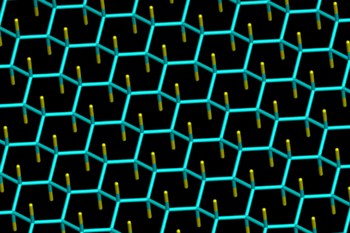Fluorographene


Fluorographene (or perfluorographane, graphene fluoride) is a fluorocarbon derivative of graphene.[1][2][3] It is a two dimensional carbon sheet of sp3 hybridized carbons, with each carbon atom bound to one fluorine. The chemical formula is (CF)n. In comparison, Teflon (polytetrafluoroethylene), -(CF2)n-, consists of carbon "chains" with each carbon bound to two fluorines.
Unlike fluorographene, graphene is unsaturated (sp2 hybridized) and completely carbon. The hydrocarbon analogue to fluorographene is sp3 hybridized graphane. Similar to other fluorocarbons (e.g. perfluorohexane), fluorographene is highly insulating. Fluorographene is relatively inert, resembling polytetrafluoroethylene; however, it can be transformed back into graphene by reaction with KI under higher temperature.[3]
Preparation
The material was first described in 2010 by Robinson et al.[1] using graphene grown on copper foil exposed to xenon difluoride at 30°C. The group of Nair et al.[2] started from cleaved graphene crystals on a gold grid also exposed to xenon difluoride, at 70°C. Also in 2010 Withers et al. described exfoliation of fluorinated graphite (monolayer, 24% fluorination)[4] and Cheng et al. reported reversible graphene fluorination.[5] The stoichiometric fluorographene (CF) was also prepared by chemical exfoliation of graphite fluoride by Zboril et al.[3] Zboril et al. also showed that the graphene fluoride can be transformed into graphene via graphene iodide, a spontaneously decomposing intermediate.[3]
Structure
Structure of fluorographene can be derived from the structure of graphite monofluoride (CF)n, which consists of weakly bound stacked fluorographene layers, and its most stable conformation (predicted for the monocrystal) contains an infinite array of trans-linked cyclohexane chairs with covalent C–F bonds in an AB stacking sequence.[6] The estimated C-F distance is equal 136-138 pm, C-C 157-158 pm and C-C-C angle 110 deg.[7] Possible fluorographene conformations have been extensivelly investigated computationally.[8][9][10][11][12][13]
Electronic Properties
Fluorographene is considered a wide gap semiconductor, because its I-V characteristics are strongly nonlinear with a nearly gate-independent resistance greater than 1 GΩ. In addition, fluorescence and NEXAFS measurements indicate band gap higher than 3.8 eV. Theoretical calculations show that estimation of fluorographene band gap is rather challenging task, as GGA functional provides band gap of 3.1 eV, hybrid (HSE06) 4.9 eV, GW 8.1 eV on top of PBE 8.1 or 8.3 eV on top of HSE06. The optical transition calculated by Bethe-Salpeter equation (BSE) is equal to 5.1 eV.[7]
Other Halogenated Graphenes
Recent studies have also revealed that, similar to fluorination, full chlorination of graphene can be achieved. Resulting structure is called as Chlorographene.[14][15] However other theoretical calculations questioned stability of chlorographene under ambient conditions.[16]
Overview on preparation, reactivity and properties of halogenated graphenes in available in ACS Nano journal free of charge.[6]
References
- ↑ 1.0 1.1 Properties of Fluorinated Graphene Films Jeremy T. Robinson, James S. Burgess, Chad E. Junkermeier, Stefan C. Badescu, Thomas L. Reinecke, F. Keith Perkins, Maxim K. Zalalutdniov, Jeffrey W. Baldwin, James C. Culbertson, Paul E. Sheehan and Eric S. Snow (2010). "Properties of Fluorinated Graphene Films". Nano Letters 10 (8): 3001–3005. doi:10.1021/nl101437p.
- ↑ 2.0 2.1 Rahul R. Nair, Wencai Ren, Rashid Jalil, Ibtsam Riaz, Vasyl G. Kravets, Liam Britnell, Peter Blake, Fredrik Schedin, Alexander S. Mayorov, Shengjun Yuan, Mikhail I. Katsnelson, Hui-Ming Cheng, Wlodek Strupinski, Lyubov G. Bulusheva, Alexander V. Okotrub, Irina V. Grigorieva, Alexander N. Grigorenko, Kostya S. Novoselov, and Andre K. Geim (2010). "Fluorographene: A Two-Dimensional Counterpart of Teflon". Small 6 (24): 2877–2884. doi:10.1002/smll.201001555.
- ↑ 3.0 3.1 3.2 3.3 Radek Zboril, Frantisek Karlicky, A.B. Bourlinos, T.A. Steriotis, A.K. Stubos, V. Georgakilas, K. Safarova, D. Jancik, C. Trapalis, and Michal Otyepka (2010). "Graphene Fluoride: A Stable Stoichiometric Graphene Derivative and its Chemical Conversion to Graphene". Small 6 (24): 2885–2891. doi:10.1002/smll.201001401.
- ↑ Withers, Freddie; Dubois, Marc; Savchenko, Alexander K. (2010). "Electron properties of fluorinated single-layer graphene transistors". Phys. Rev. B 82: 073403. doi:10.1103/PhysRevB.82.073403.
- ↑ Reversible fluorination of graphene: Evidence of a two-dimensional wide band gap semiconductor S.-H. Cheng, K. Zou, F. Okino, H. R. Gutierrez, A. Gupta, N. Shen, P. C. Eklund, J. O. Sofo, and J. Zhu Phys. Rev. B 2010; 81, 205435 doi:10.1103/PhysRevB.81.205435
- ↑ 6.0 6.1 Karlicky F, Datta KKR, Otyepka M, Zboril R Halogenated Graphenes: Rapidly Growing Family of Graphene Derivatives. ACS Nano, 2013, 7 (8), pp 6434–6464 doi:10.1021/nn4024027
- ↑ 7.0 7.1 Karlicky F, Otyepka M 'Band Gaps and Optical Spectra of Chlorographene, Fluorographene and Graphane from G0W0, GW0 and GW Calculations on Top of PBE and HSE06 Orbitals. J. Chem. Theory. Comput., 2013, 9 (9), doi:10.1021/ct400476r
- ↑ Artyukhov, V. I. and Chernozatonskii, L. A., Structure and Layer Interaction in Carbon Monofluoride and Graphane: A Comparative Computational Study. J. Phys. Chem. A, 2010, 114 (16), pp 5389–5396 doi:10.1021/jp1003566
- ↑ Leenaerts, O., Peelaers, H., Hernández-Nieves, A. D., Partoens, B. and Peeters, F. M., First-principles investigation of graphene fluoride and graphane. Phys. Rev. B 82, 195436 (2010) doi:10.1103/PhysRevB.82.195436
- ↑ Samarakoon, D. K., Chen, Z., Nicolas, C. and Wang, X.-Q. , Structural and Electronic Properties of Fluorographene. Small, n/a. doi:10.1002/smll.201002058
- ↑ Structural and Electronic Properties of Hybrid Fluorographene–Graphene Nanoribbons: Insight from First-Principles Calculations Shaobin Tang, Shiyong Zhang The Journal of Physical Chemistry C Article ASAP doi:10.1021/jp204880f
- ↑ Sahin H., Topsakal M., and Ciraci H., Structures of fluorinated graphene and their signatures, Physical Review B 83, 115432 (2011) doi:10.1103/PhysRevB.83.115432
- ↑ Garcia, J. C.; de Lima, D. B.; Assali, L. V. C.; Justo, J. F. (2011). "Group IV graphene- and graphane-like nanosheets". J. Phys. Chem. C 115: 13242. doi:10.1021/jp203657w.
- ↑ Sahin, H. "Chlorine Adsorption on Graphene: Chlorographene".
- ↑ Li, B. "Photochemical Chlorination of Graphene".
- ↑ Karlicky, F et al. "Band gaps and structural properties of graphene halides and their derivates: A hybrid functional study with localized orbital basis sets".
See also
- "Chlorographene"
- Organofluorine chemistry
- Organofluorine compound
- Diamond
- Graphane